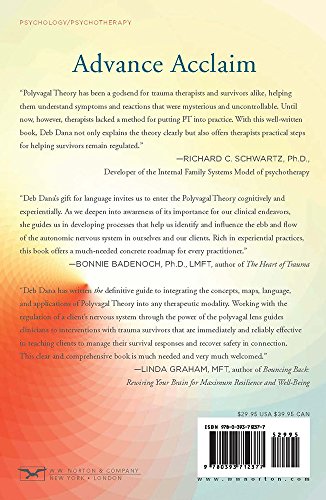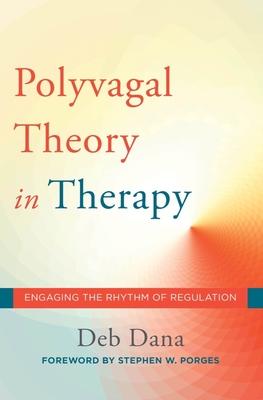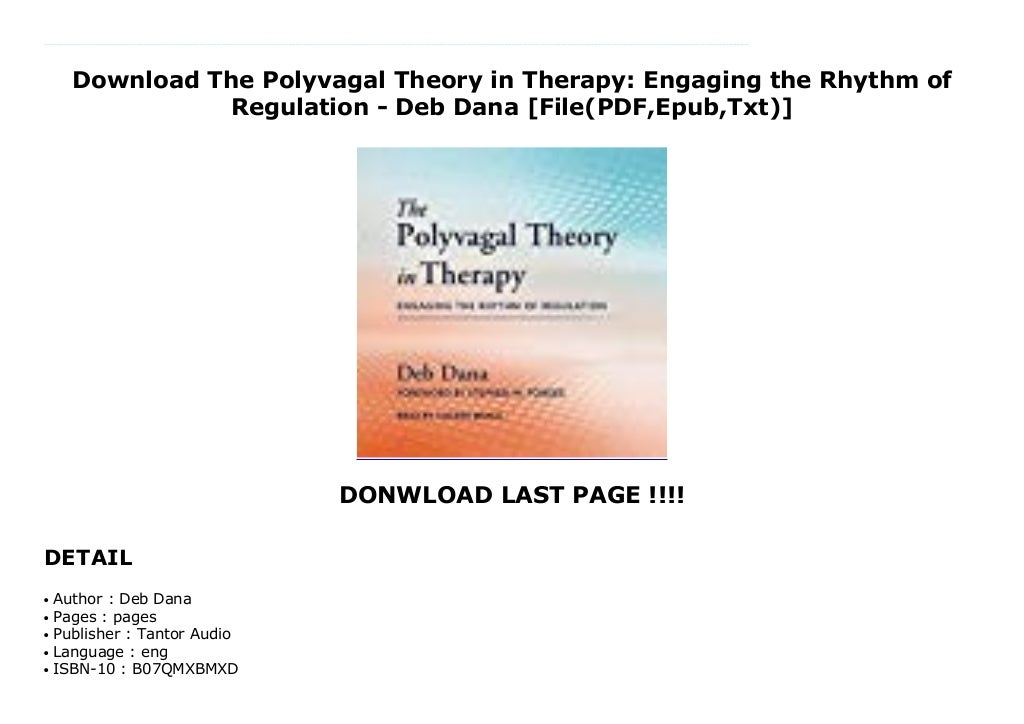The Polyvagal Theory In Therapy Engaging The Rhythm Of Regulation
The Polyvagal Theory in Therapy: Engaging the Rhythm of Regulation is an insightful book that explores the powerful concept of the Polyvagal Theory and its application in therapy. This theory, developed by Dr. Stephen Porges, revolutionizes our understanding of the autonomic nervous system and its role in regulating our responses to stress and trauma.
The Polyvagal Theory: A Brief Overview
The Polyvagal Theory suggests that our autonomic nervous system comprises not just the well-known fight-or-flight response but also a more nuanced hierarchy of physiological states. This theory classifies three distinct states: the social engagement system, the sympathetic fight-or-flight system, and the dorsal vagal freeze response.

Image source: Twitter
The social engagement system, also known as the ventral vagal complex, facilitates our ability to connect with others and form secure attachments. It is associated with feelings of safety and relaxation. In contrast, the sympathetic fight-or-flight system prepares us for action and mobilization when faced with a threat or danger.
The Importance of Understanding Polyvagal Theory in Therapy
Understanding the Polyvagal Theory is essential in the field of therapy as it provides a new lens through which to view trauma and stress-related disorders. By recognizing the interconnectedness of our nervous system, therapists can help individuals regulate their physiological responses and develop healthier coping strategies.
Benefits of Applying Polyvagal Theory in Therapy
1. Improved Self-Regulation: By understanding the different states of the autonomic nervous system, therapists can help individuals develop self-regulation skills. This enables clients to shift from states of fight-or-flight or freeze to a more calm and connected state.
2. Increased Resilience: Through Polyvagal Theory-informed therapy, individuals can regain a sense of safety and control over their responses to stress and trauma. This, in turn, enhances their resilience and ability to cope with challenging life circumstances.
3. Enhanced Therapeutic Alliance: Incorporating the principles of the Polyvagal Theory allows therapists to create a safe and supportive therapeutic environment. This strengthens the therapeutic alliance, fostering trust and rapport between the therapist and client.
Common Questions about Polyvagal Theory in Therapy
Q: Is the Polyvagal Theory applicable to all individuals?
A: Yes, the Polyvagal Theory is applicable to all individuals, as it is based on the fundamental physiological responses of the autonomic nervous system. Regardless of age, gender, or background, understanding the Polyvagal Theory can benefit everyone.
Q: How can the Polyvagal Theory help individuals who have experienced trauma?
A: When trauma occurs, individuals may become stuck in a heightened state of fight-or-flight or freeze response. The Polyvagal Theory offers a framework for understanding these responses and provides tools for therapists to help individuals regulate their nervous system, find safety, and heal from trauma.
Q: Can I practice self-regulation techniques based on the Polyvagal Theory myself?
A: Absolutely! Learning self-regulation techniques based on the Polyvagal Theory can be empowering. However, it is important to remember that therapy with a certified professional is often necessary when dealing with trauma or chronic stress.
The Polyvagal Theory in Therapy: Engaging the Rhythm of Regulation is a must-read for therapists, counselors, and anyone interested in understanding the intricate workings of our autonomic nervous system. By integrating the principles of the Polyvagal Theory into therapy, professionals can help individuals overcome trauma, build resilience, and lead healthier, more connected lives.

Image source: ardhindie.com
The Polyvagal Theory In Therapy, Engaging The Rhythm Of Regulation
theory polyvagal trauma vagal poly therapy porges system nervous ptsd flight fight regulation nerve vagus rhythm stephen safety presence states
Polyvagal Theory Exercises Pdf - Pdfjuld
 Image Source : pdfjuld.blogspot.com
Image Source : pdfjuld.blogspot.com [PDF] The Polyvagal Theory In Therapy: Engaging The Rhyt
![[PDF] The Polyvagal Theory in Therapy: Engaging the Rhyt](https://ardhindie.com/wp-content/uploads/2019/04/1556004973_312_the-polyvagal-theory-in-therapy-engaging-the-rhythm-of-regulation-norton-series-on-interpersonal-neurobiology.jpg) Image Source : ardhindie.com
Image Source : ardhindie.com polyvagal theory interpersonal regulation
'READ [PDF]] The Polyvagal Theory In Therapy: Engaging The Rhythm Of
!['READ [PDF]] The Polyvagal Theory in Therapy: Engaging the Rhythm of](https://pbs.twimg.com/media/FMf2EP3VQAAa1RJ.jpg) Image Source : twitter.com
Image Source : twitter.com The Polyvagal Theory In Therapy: Engaging The Rhythm Of Regulatio…
 Image Source : www.slideshare.net
Image Source : www.slideshare.net polyvagal therapy rhythm theory engaging
The Polyvagal Theory In Therapy: Engaging The Rhythm Of Regulation By
 Image Source : www.discountmags.com
Image Source : www.discountmags.com Read The Polyvagal Theory In Therapy: Engaging The Rhythm Of Regulati…
 Image Source : fr.slideshare.net
Image Source : fr.slideshare.net engaging polyvagal rhythm dana
Deb Dana Polyvagal Worksheets
 Image Source : materiallibrarykerr99.z21.web.core.windows.net
Image Source : materiallibrarykerr99.z21.web.core.windows.net Deb dana polyvagal worksheets. The polyvagal theory in therapy: engaging the rhythm of regulatio…. Polyvagal therapy rhythm theory engaging. Polyvagal theory exercises pdf. Engaging polyvagal rhythm dana